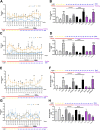Bacteroides uniformis CECT 7771 Modulates the Brain Reward Response to Reduce Binge Eating and Anxiety-Like Behavior in Rat
- PMID: 34228269
- PMCID: PMC8497301
- DOI: 10.1007/s12035-021-02462-2
Bacteroides uniformis CECT 7771 Modulates the Brain Reward Response to Reduce Binge Eating and Anxiety-Like Behavior in Rat
Abstract
Food addiction (FA) is characterized by behavioral and neurochemical changes linked to loss of food intake control. Gut microbiota may influence appetite and food intake via endocrine and neural routes. The gut microbiota is known to impact homeostatic energy mechanisms, but its role in regulating the reward system is less certain. We show that the administration of Bacteroides uniformis CECT 7771 (B. uniformis) in a rat FA model impacts on the brain reward response, ameliorating binge eating and decreasing anxiety-like behavior. These effects are mediated, at least in part, by changes in the levels of dopamine, serotonin, and noradrenaline in the nucleus accumbens and in the expression of dopamine D1 and D2 receptors in the prefrontal cortex and intestine. B. uniformis reverses the fasting-induced microbiota changes and increases the abundance of species linked to healthy metabolotypes. Our data indicate that microbiota-based interventions might help to control compulsive overeating by modulating the reward response.
Keywords: Bacteroides uniformis CECT 7771; Binge eating; Dopamine; Food addiction; Gut–brain axis; Microbiota; Preclinical model; Reward system.
© 2021. The Author(s).
Conflict of interest statement
The authors declare no competing interest.
Figures








References
MeSH terms
Supplementary concepts
Grants and funding
- AGL2014-52101-P/Ministry of Science, Innovationa and Universities (MCIU, Spain)
- AGL2017-88801-P/Ministry of Science, Innovation and Universities (MCIU,Spain)
- PROMETEO/2019/015/Conselleria de Educación, Investigación, Cultura y Deporte de la Comunidad valenciana
- AGL2017-88801-P/Ministry of Science, Innovation and Universities (MCIU, Spain)
- PTA/Ministry of Science, Innovation and Univesities (MCIU, Spain)
LinkOut - more resources
Full Text Sources
Medical

